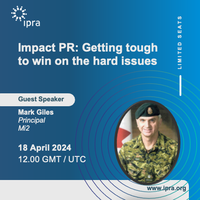
AI Guidelines
The IPRA AI and PR Guidelines
Context to generative AI
Generative artificial intelligence (AI) is a type of artificial intelligence system capable of generating text, images, video, audio, and human-like conversations. It has been enabled by advances in machine learning, whereby computers teach themselves by analysing large quantities of data typically from the internet. Thus, the original data used by AI suffers from the flaws of misinformation on the Internet. Moreover, the algorithms to output the data were developed by humans and so have the potential for bias. This means that at every step AI output inherently contains misinformation and bias.
A further issue is that generative AI content can be indistinguishable from human-generated content.
Generative AI is a transformational technology and will be used by public relations professionals. These guidelines cover the intersection between generative AI and public relations.
IPRA and generative AI
Throughout its existence IPRA has provided intellectual leadership for the public relations profession. A key part has been the development of codes to provide an ethical framework for the profession. IPRA members uphold these codes and in doing so benefit from the ethical climate that they create. The 2011 code consolidated the 1961 Code of Venice, the 1965 Code of Athens and the 2007 Code of Brussels. The code was reviewed in 2020. The current IPRA Code of Conduct is an affirmation of ethical conduct by members of IPRA and recommended to public relations practitioners worldwide. Moreover, Academia has embraced the need for learning on the use of AI and has called for guidance.
Generative AI has the potential to enhance PR. It also has the potential for bias, misuse, deception, and harm. Thus, PR practitioners who use generative AI face reputational risks.
Given IPRA’s history of ethical codes, the IPRA Board has decided to issue guidelines with respect to the use of AI in PR. These guidelines take 5 of the 18 articles of the IPRA code of conduct and interpret implementation with respect to the use of generative AI in public relations. The Board is cognizant that AI is a fast-evolving technology and will revisit these guidelines accordingly.
In these guidelines AI content means content produced with generative AI tools.
The IPRA AI and PR Guidelines
RECALLING that public relations practitioners through their communication skills possess a unique means of influence;
RECALLING that digital channels of communication are channels where erroneous or misleading information may be widely disseminated and remain unchallenged, and therefore demand special attention from public relations practitioners to maintain trust and credibility;
RECALLING that AI content has the potential both to enhance public relations, and the potential for bias, misuse, deception, and harm;
In the use of AI content in communications public relations practitioners will implement:
1. article two of the IPRA code to act with honesty and integrity by
- determining in advance when AI content will be used for an external communication and if so, ensure these guidelines are followed.
2. article four of the IPRA code to be open and transparent by
- ensuring that AI content is disclosed as such
- ensuing that regulatory guidelines relating to AI disclosure are followed
- implementing style guidelines for the identification of such disclosures.
3. article six of the IPRA code to honour confidential information by
- establishing staff training on what constitutes confidential or copyrighted information
- avoiding entering confidential information into AI tools
- avoiding the use of AI content from copyrighted information.
4. article seven of the IPRA code to ensure truth and accuracy by
- ensuring AI content is fact-checked by humans with relevant expertise
- ensuring AI content is corrected by humans to remove bias.
5. article eight of the IPRA code to not disseminate misleading information by
- exercising proper care to avoid the dissemination of misinformation
- ensuring any inadvertent dissemination of misinformation is corrected promptly.
Adopted October 2023
Latest Ipra ITL:

ITL #572 My experience transitioning from PR to media: proof that it can go the other way, too

ITL #571 Humanizing B2B brands in Japan: how to leverage the power of storytelling in PR strategies

ITL #570 Different, yes: bridging the generation gap with open dialogue

ITL #569 Look inside for the answers: the growing link between reputation and culture




